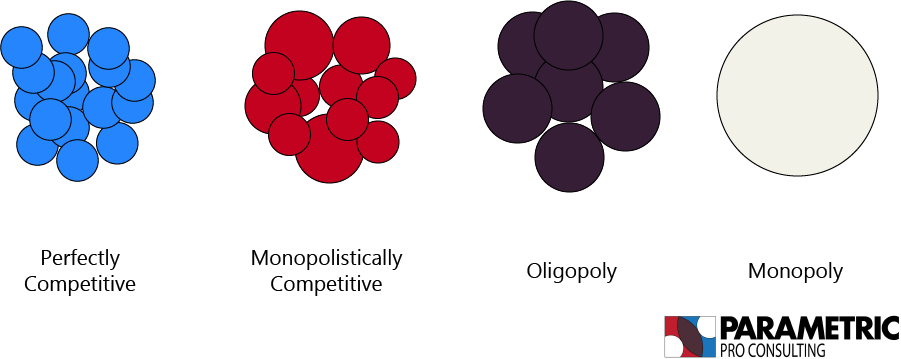Introduction
From an outside perspective, market structures may seem complex and challenging to categorize; however, it is crucial to understand which type of market you occupy and which strategies to deploy to maximize profits in the marketplace.
There are, fundamentally, 4 main market structures in an economy: perfectly competitive, monopolistically competitive, oligopolies, and monopolies (see Figure 1). Each market structure demands different performance and produces different profits. It’s important to note that these categorizations look at the condition of firms in an industry – and not the condition of buyers in an industry, which will be explored further below.

Competitive Markets
The first market structure we’ll look at are perfectly competitive markets. Perfectly competitive markets are categorized by their lack of product differentiation and lack of long-term profits. Economists often use agriculture as an example for perfect competition; however, in reality, most sectors in agriculture are run by oligopolies that benefit from economies of scale. Perfectly competitive markets have firms who are price takers. In theory, there are far too many firms in the marketplace to have price-maker power, since all products are homogeneous.
As a firm, it is very challenging to prosper in a perfectly competitive market. There are usually low barriers to entry, which theoretically floods the market and subsequently dilutes profits to near-zero in the long-term.
Monopolistically Competitive
The next market structure is monopolistically competitive. This market structure is characterized by slightly larger barriers to entry and product differentiation. In this market, unlike perfectly competitive markets, buyers have distinct demand curves for products. This allows firms to price their products according to what buyers are willing to pay for them, instead of what other firms are willing to sell for. An example of a monopolistically competitive market are restaurants.
In a monopolistically competitive market, sustained profits can be achieved, but pricing is still partially dependent on the pricing of other firms.
Oligopolies
The third market structure to understand are oligopolies. Oligopolies are characterized by large barriers to entry and a limited number of firms. Firms in this market structure are strategically interdependent and usually produce strong profits. Since there are a limited number of firms in this market, cartelization is a reality. A cartel is a group of firms that collude to fix prices and generate higher profits. Price fixing consistently creates deadweight loss and reduces the total utility in a market structure. An example of an oligopoly would be the automobile industry. Furthermore, an example of a cartel would be the Organization of the Petroleum Exporting Countries (OPEC), who limit and control the global supplies of oil.
Monopolies
Finally, we’ll look at monopolies. There are two main types of monopolies: natural monopolies and legal monopolies. Legal monopolies are monopolies created by legally preventing competition. Natural monopolies, in contrast, are created without government intervention. An example of a legal monopoly would be BC Hydro, British Columbia’s sole electricity provider. An example of a new natural monopoly would be Amazon, who is able to acquire their competitors and drive down marginal costs as sales increase. Monopolies typically produce where they maximize profits, instead of where they maximize consumer utility.
Monopsony
We’ve covered the structure of suppliers in a market, but understanding the power dynamics of being a buyer can provide a firm with large amounts of leverage. The main concept that is crucial to understand is called monopsony. A monopsony is a market structure where there is a limited or singular number of buyers (see Figure 2). One firm that has taken advantage of this market structure more effectively than most firms is Trader Joe’s. Trader Joe’s strategically chooses small scale manufacturers for their product lines. This has two major advantages: the products appear to be higher quality, since they are manufactured on a smaller scale, and it creates a natural monopsony for Trader Joe’s. Once the supply contracts have been established, Trader Joe’s typically becomes the sole buyer from the manufacturer and can drive down their costs via massive negotiating power.

Conclusion
Markets define how a firm can operate. By understanding them, you can tune your strategy to the market conditions. Now that we’ve looked at the main types of market structures, you can take a look at your industry and what type of market structure you’re operating in.
If your business could use a boost, book a free consultation with us and we can work together to achieve your goals.
If you liked this post, please consider sharing it with your network!
Check out our Business Strategy Frameworks and Marketing Starter Kit guides for more useful tools.
Are you interested in the consulting industry? Parametric Pro Consulting Foundations offers more in-depth knowledge on this article as well as several other topics to prepare you for a career in business and consulting. Check it out here!
